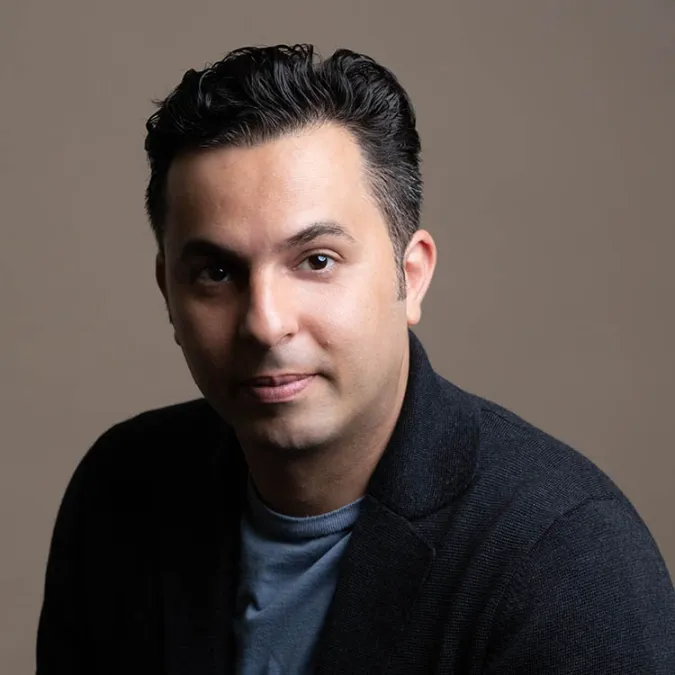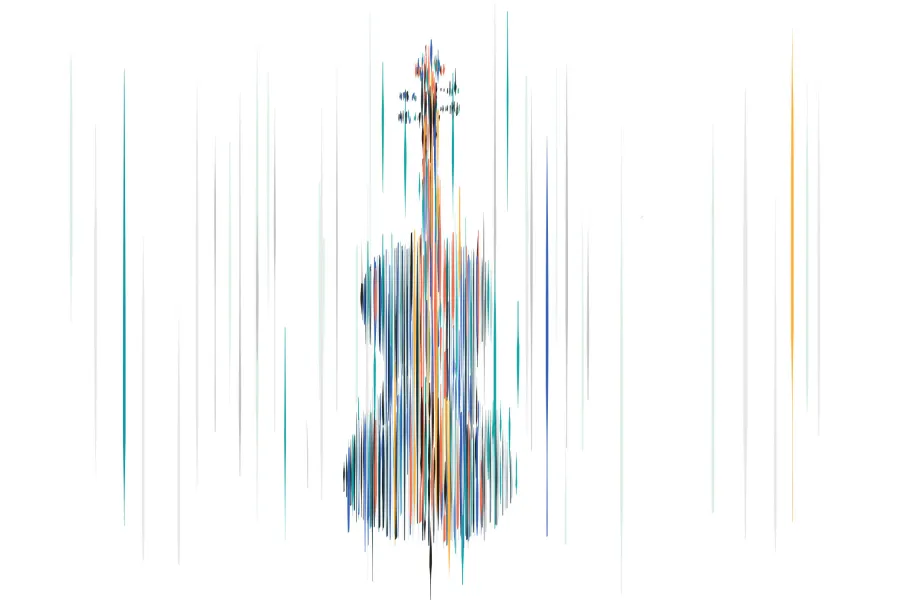Farkhad Khudyev, conductor
This concert will last about 65 minutes without intermission.
Please silence your electronic devices.
Photography, video, or recording of any part of this performance is prohibited
Program
Niyazi Hajibeyov
Final Dance “Chitra” Ballet Suite
Dimitri Shostakovich
Symphony No. 10, in E Minor, op. 93
Moderato
Allegro
Allegretto
Andante: Allegro
About the Program
Program notes by Mark Bilyeu
Niyazi Tagizade Hajibeyov
Suite from the Ballet Chitra
Born August 20, 1912, Tbilisi
Died August 2, 1984
Composed 1971
Duration 5 minutes
Born into a wildly musical family at the height of the Soviet Union, Niyazi Hajibeyov stands as one of Azerbaijan's most storied and celebrated figures. He studied at Russia’s Gnessin Music School (M.F. Gnessin was his composition teacher) before moving to Leningrad. The twenty-six year old came to prominence when his uncle, the conductor Uzeyir Hajibeyov, fell ill before a propaganda-filled marathon of the elder’s operas which the Soviet State called “The Ten Year Festival of Azerbaijani Arts.” He called on his nephew to conduct the three operas in front of Stalin at the Bolshoi Theatre. The event was a success, and launched Niyazi (he would come to be known simply by his first name) into the Soviet spotlight as one of the greatest symphonic conductors of the time, and a golden child of the State. He was honored as the People’s Artist of the USSR in 1959, and received the Stalin Prize twice (1951, 1952). His compositional career, although often overlooked, was robust. In 1962, he crafted a lyrical ballet entitled Chitra, based on the works of Indian writer Rabindranath Tagore, and in 1971 he crafted this suite from the score, which won the international Nehru Prize (named after India’s first prime minister) in 1974.
Dmitri Shostakovich
Symphony No. 10 in E Minor, Op 93
Born September 25, 1906, Saint Petersburg, Russia
Died August 9, 1975, Moscow, Russia
Composed 1951-1953
Premiered December 17, 1953, Leningrad Philharmonic Orchestra, Yevgeny Mravinsky, conductor
Duration 50 minutes
In 1946, the high-ranking Soviet Union leader named Andrei Zhdanov crafted a cultural doctrine which sought to mandate Soviet art; pitting the ‘imperialistic’ art of the United States against the ‘democratic’ art of the Soviet Union. This Zhdanov Doctrine (or Zhdanovism as it was called) could be distilled down to the motto “The only conflict that is possible in Soviet culture is the conflict between good and best.” Shostakovich denounced this governmental intrusion: the beginning of a storied antagonism between the famous composer and the Soviet rulers. In 1948, Shostakovich was then denounced by the government (again), lost his position teaching at the Conservatory, and made the conscious decision to lay low—his life depended on it. When Stalin died on March 5, 1953 Shostakovich was given a new lease on his compositional life, and immediately set out to craft a symphony—he very idiom that forced him to withdraw in 1948. The first movement of his tenth symphony is nearly half of the work’s total length, and Shostakovich uses that time to explore two thematic ideas: a slow near-dirge that unwinds and unfolds into a gruesome brass chorale before morphing into the second section built around an unsettling waltz, complete with the bone-chilling military sounds of piccolo and drum. The second movement is what Shostakovich described as “a musical portrait of Stalin” in his memoir Testimony (although, it must be said that this publication has been the center of much scholarly criticism for some questionable journalism from its writer, which continues to live alongside staunch support for its recounting by the likes of Rostropovich and Shostakovich’s son). The third movement offers material based on that of Shostakovich’s own name and that of his student, Elmira Nazirova. In the same style and coding that so many have done before him, Shostakovich created a musical signature using the first letter of his first name and the first three of his last: D-S-C-H, translating musically to D, E-flat, C, and B. We hear this motive introduced by the flutes and clarinets about a minute into the movement. About a minute later, we hear a solo horn call out a new theme, this time it is a hybrid of Germanic spellings and solfege to offer “Elmira”: E-A-E-D-A, or E-La-Mi-Re-A. The two themes alternate and entwine before it closes with a lone D-S-C-H in the flute and piccolo. The final movement begins slowly until the clarinet announces an Allegro of near-hysteria, bringing back ideas from the first movement, and the return of the D-S-C-H theme, this time declared by a deafening full orchestra. The symphony concludes with what Walt Whitman called a “barbaric yawp;” the declaration of “I’m still here!” from a composer who was once labeled a “non-person” by a dehumanizing regime. As the annotator John Mangum writes so perfectly: “Shostakovich’s Tenth Symphony is 48 minutes of tragedy, despair, terror, and violence and two minutes of triumph.”
About the Artists
Farkhad Khudyev

Farkhad Khudyev is the winner of the Gold Medal “Beethoven 250” at the 1st International Arthur Nikisch Conducting Competition; the Solti Foundation US 2018 and 2022 Career Assistance Award; the Best Interpretation Prize at the 1st International Taipei Conducting Competition; the 3rd prize at the 8th International Sir Georg Solti Conducting Competition; and the Gold Medal/Grand Prize at the 2007 National Fischoff Competition. Khudyev has worked with orchestras worldwide including the London Philharmonic Orchestra, Frankfurt Radio Symphony Orchestra, Frankfurt Opera Orchestra, Danish National Symphony Orchestra, Seattle Symphony, Dallas Symphony, Los Angeles Philharmonic, San Diego Symphony, Monterey Symphony, George Enescu Philharmonic Orchestra, Xi’an Symphony Orchestra and the State Taipei Chinese Orchestra. Farkhad was born in Turkmenistan, where he studied at the State Music School for gifted musicians, and then completed his studies at Interlochen Arts Academy, Oberlin Conservatory and Yale University. Khudyev serves as the Music Director of the University of Texas Symphony Orchestra in Austin, and the Orchestral Institute at the Hidden Valley Institute of the Arts in Carmel, California.
Symphony Orchestra
VIOLIN I
Yusong Zhao, concertmaster
Brandon Garza
Yida An
Suhaas Patil
Shijie Li
Wells Gjerlow
Kyle Adams
Sui Shimokawa
Peter Kim
Jackie Shim
Yvonne Ma
Noah Briones
VIOLIN II
Zichuan Wang, principal
Chloe Yofan
Mei Liu
Zi Wang
Kai Lindsey
Jordan Bartel
Jimmy Shim
Georgia Halverson
Alice Pak
Pedro Salas
Kai Cole
Leiana Campanaro
Ivan Arras Morales
VIOLA
Liam Cao, principal
Thomas Gougeon
Harrison Knight
Gwendolyn Lay
Grace Dias
Cecilia Nguyen
CELLO
Wesley Fu, principal
Katsuaki Arakawa
Javy Liu
Arturo Gonzalez
Seungyeon Oh
Christopher Tran
Aidan Bolding
Zachary Houlton
William Pu
Kyra Hong
Tristan Ramon
DOUBLE BASS
Andres Hernandez Labra, principal
William Penn
Kaitlyn Ruiter
Xingchang Ye
Lydia Chen
Eddie Otto
Ema Deguchi-Kelly
Jewelie Lujan
Natalia Guerra
Mirabai Weatherford
FLUTE
Subin Oh, principal
Diego Arias
Nichole Thompson
OBOE
E.M. Shank, principal
Zane Laijas
Mary Creel
CLARINET
Andrew Battaglia, principal
Alex Vo
Chase Cano
BASSOON
Thomas Klink, principal
Isabella Perez
Rishabh Sajjan
HORN
Lucas Hamilton, principal
Charlotte Allen
Stephanie Chiang
Jenny Wu
Cheryll Huddlleston
TRUMPET
Harmon Byerly, principal
Guillem Torro Senent
Jax Latham
Harrison Whitfield
TROMBONE
Cristian Cantu, principal
Jorge Rodriguez
Jackson Quevedo
TUBA
Tyler Lane
PERCUSSION
Kevin Luo
Michael Rivera Gonzalez
Clinton Washington
Isabella Scotti
Ashley Hsu
Victoria Garcia
Daniel Hernandez
PIANO
Xiaoyi Lin
Event Details
$5 – 15
All University of Texas at Austin students are allowed one free ticket as long as they are available. Student tickets must be picked up at the Box Office with valid student I.D. Seating is unassigned.
If you are a patron with specific seating needs, please email tickets@mail.music.utexas.edu and we will reserve ADA seating for you.


